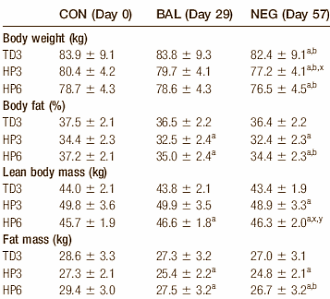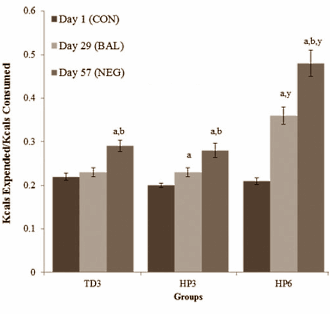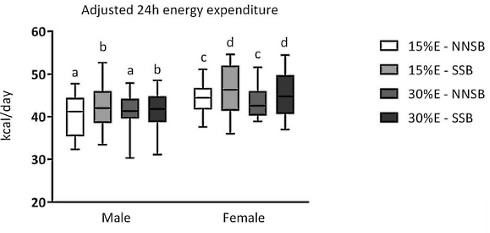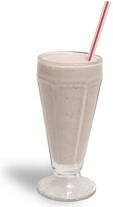|
Protein-rich slimming diet works even better with six meals a day
The absolutely best diet for losing fat and retaining muscle mass is of course a diet that is relatively rich in proteins - where 30% instead of 15 % of your energy comes from protein. Nutritionists at Skidmore College in the US have found a way to make a protein-rich diet even more effective: by increasing the number of meals you eat per day.
Study
The researchers conducted an experiment involving 30 inactive overweight people, average age of 45, that lasted for 2 periods of 28 days [so in total 56 days].
During the first period the subjects ate exactly the same number of calories every day as they burned [BAL]; during the second period they were only given 75 percent of the number of calories they burned daily [NEG].
One group ate according to traditional nutritionists' advice: three meals a day, with 15 percent of the calories coming from protein, 60 percent from carbohydrates and 15 percent from fat [TD3].
The second group was put on a protein-rich diet. The energy was derived for 35 percent from protein, 45 percent from carbohydrates and 20 percent from fat. The test subjects in the second group ate three meals a day [HP3].
The third group was also put on a protein-rich diet. The test subjects in the third group ate not three but six meals a day [HP6].
Results
As expected, the subjects in the high-protein diet groups lost more fat than the group on the traditional diet. But fat loss was faster in the high-protein group that ate six times a day. Moreover, this group gained more lean body mass, while the high-protein group that ate three times a day lost a small amount of lean body mass.


During the experiment the researchers measured the amount of calories that the subjects burned after a meal a couple of times. They used the results to produce the figure below. It shows the relationship between calorie intake and the calories burned by the body.
As you can see, a protein-rich diet boosts energy expenditure, and this effect is boosted by eating six rather than three meals a day.

Conclusion
"When expressed as a ratio of total kcals expended to kcals consumed, the increase in thermogenesis was more pronounced in HP6 (128%) compared to HP3 and TD3", the researchers write.
"Extrapolating to all meals eaten during the BAL and NEG period (56 days total) would result in an expenditure of 3444.0, 3259.2, and 6333.6 total kcals for TD3, HP3, and HP6, respectively, and clearly highlights the profound impact of increased dietary protein and meal frequency on thermogenesis and body composition."
Source:
Obesity (Silver Spring). 2013 Jul;21(7):1357-66.
More:
Weight gain from eating more protein: more lean body mass, not more fat 10.02.2012
Slimming goes better with proteins than with fibre 24.01.2012
Follow a protein diet and your energy intake will drop by 500 kcal 25.10.2010
Archives:
Weight Loss Supplements
Weight Loss
Protein
 |
 |
 |
|
Whey is a hormonal appetite suppressant
If you become obsessed with the constant appetite for food during weight loss attempts, try incorporating whey protein shakes into your diet. This will decrease your appetite for food, while at the same time increasing the chance that you will actually lose those excess pounds.
|
Fat percentage too high? Add rice protein to your shake
If you want to be leaner, then an excellent strategy is to make your diet more protein rich. Instead of sandwiches for lunch a protein shake can do wonders for your fat percentage, according to various studies.
|
Soft drink ruins slimming effect of high-protein diet
Increasing the amount of protein in your diet - replacing as many carbs and fats as possible - is the best dietary strategy if you want to lose weight but retain muscle mass.
|
|







